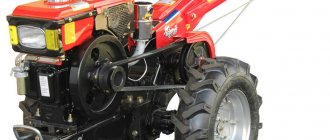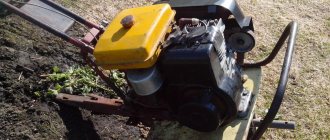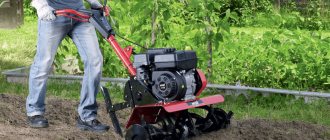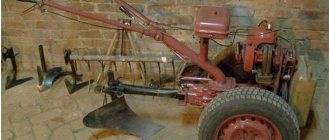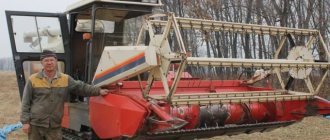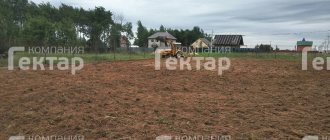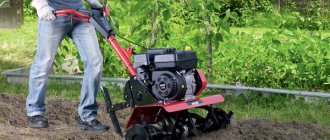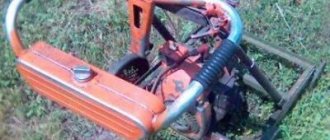A modern summer resident often faces a problem: how to quickly and efficiently cultivate a plot of land. We recommend choosing a walk-behind tractor or cultivator for this. They are ideal for a large vegetable garden, and the set of attachments makes them indispensable on the farm.
- Why is it necessary to till the soil?
- What is the difference between cultivation and plowing
- What types of walk-behind tractors are there?
- What engines and fuel are used in walk-behind tractors?
- Important technical parameters of walk-behind tractors
- What types of cultivators are there?
- What engines and fuel are used in cultivators
- Important technical parameters of cultivators
- What additional attachments are used?
Why is it necessary to till the soil?
There are several reasons to plow and cultivate the land:
Salinity and lack of oxygen
The upper layer of the earth dries out, and in the deeper layers moisture is retained and salt is deposited. Productivity depends on this. If the top layer is loosened and turned over, the soil receives oxygen. It is necessary for important microorganisms.
Weeds and pests
After plowing, the weed roots die in the sun or die from damage.
Soil erosion or excessive compaction
Wind erosion blows away the fertile part of the land. Soil compaction compresses the pores that should conduct water and air. This prevents root growth.
Previously, summer residents used a shovel or horses for such excavation work. Hand cultivators cope well with tasks in oversized summer cottages with well-groomed soil, small flower beds and beds. On hard ground it is difficult to use hand tools. Not everyone can physically work like this. Therefore, in modern dachas, large gardens and vegetable gardens, walk-behind tractors, cultivators and mini-tractors are used.
Mechanization of manual labor provides many advantages, including saving time, effort and efficient performance of such work as:
- plowing the land;
- cultivation;
- preparing furrows for planting;
- hilling;
- digging up root crops.
Differences
The main difference between a walk-behind tractor and a cultivator is the different range of capabilities. A completely reasonable question arises: is it better to plow the land with a cultivator or a walk-behind tractor?
Any cultivator, for example, one for a garden, a manual one for a summer house, an electric one, a mini walk-behind tractor, can only loosen the soil, albeit in some models to different depths, regulated by raising and lowering a single working element.
It is intended exclusively for soil cultivation. In this regard, its power is low and its capabilities are limited. Powered by an electrical source, outlet or battery , sometimes it is gasoline, and the very first models are simply mechanical - they are powered by human power.
The walk-behind tractor has a wider range of functions. This is due to the fact that this tool necessarily has an engine, most often a gasoline one, and a chassis. In fact, they are the basis of the entire unit. Various attachments are added to this base, which provide the desired type of work. With their help it is not difficult:
- plow;
- loosen and weed;
- hill up and survey;
- harvest some crops;
- mow the grass;
- clear paths;
- remove snow;
- transport cargo in a trailer.
Thus, a cultivator is a seasonal, highly specialized tool, and a walk-behind tractor is a universal one used all year round.
What is the difference between cultivation and plowing
If, during plowing of a plot, the earth is turned over in layers, then in the case of cultivation, it is loosened to a certain depth, thereby the fertile layer of soil remains in place.
As the cultivator passes, the top layer of soil loosens and crumbles, resulting in mixing of the soil. Afterwards the area is leveled and visually enlarged. During cultivation, the roots of harmful plants and weeds are also pruned. This is especially necessary after winter, when the pressure of snow and moisture causes the soil to become compacted.
The importance of arable work in the country is complemented by labor intensity. This is physically difficult work, so choosing the right assistant device can greatly facilitate tasks on the land. Thus, 10 acres of land can be cultivated not in 2 days, as by hand, but in 2-3 hours. So what should you buy: a walk-behind tractor or a cultivator?
Results
Which is better: a walk-behind tractor or a walk-behind cultivator cannot be answered unequivocally. Comparing these units is incorrect; it’s like putting a tractor and a car on the same page. Each technique has its own functions and features. The walk-behind tractor copes more confidently with cultivating the land and other operations, but it “eats” a lot of gasoline. A motor cultivator is more economical, lighter, more maneuverable, but not as practical; the capabilities of this equipment are limited.
Land owners choose small-scale mechanization according to their needs; there is no point in overpaying if there is a lawn and a small number of beds on the site. With a large volume of agricultural work and farming, powerful motor vehicles with wide functionality are needed.
What engines and fuel are used in walk-behind tractors?
Walk-behind tractors are equipped with both gasoline and diesel engines.
Diesel engines are found infrequently, mainly on medium and heavy (professional) devices. They have a four-stroke configuration, are simple and reliable in operation.
Gasoline engines are high-power and efficient. Gasoline walk-behind tractors can be two- or four-stroke. The two-stroke is fueled with a mixture of gasoline and oil, and the four-stroke is fueled with pure fuel. An engine running on pure gasoline is less noisy and does not require much fuel.
Gasoline walk-behind tractors are lighter than diesel ones, making it easier to maneuver when working with soil. Diesel fuel is cheaper due to low consumption, but such walk-behind tractors are more expensive.
kronos5.by
4385 rub.
All stores (1)
Petrol walk-behind tractor MTZ Belarus-09N (Honda 9.0)
4385 rub.
Engine power: 9 hp; engine capacity: 270 cm3; fuel tank volume: 6 l; fuel: gasoline.
Description Where to buy (1)
Walk-behind tractors use tanks with a capacity of 3.6 or 6 liters, but there are also larger devices with tanks of 8.5 and 10 liters. When choosing, rely on the amount of work to be done and compare it with fuel consumption. The approximate consumption of this garden equipment is 1 liter per hour.
What can a motor cultivator do?
- Motorized cultivators are mainly intended only for plowing (cultivating) land. His main working tool is cutters.
- Depending on the power, such equipment can cope with soil of different densities and loosen the soil to a depth of 25 cm. The plowing width depends on the number of cutters that can be mounted at the same time.
- The power of the cultivator engine does not exceed 9 horsepower, but more often these are options with a 2-5 horsepower engine.
- In addition to plowing, with the help of a motor cultivator you can hill up beds (for example, potato beds), remove snow and sometimes some other types of work.
The motor cultivator is not too heavy and bulky - most models can be loaded into a car alone. However, some powerful units can weigh up to 100 kg.
A motor cultivator is an excellent choice for cottages and small areas
All of the above allows us to draw the following conclusion: if you have little personal land, for example, a plot in a dacha community or a vegetable garden of up to 10-12 acres in the private sector, then a motor cultivator with a gasoline engine will cope with most of the tasks. In a multitasking situation, a lightweight gasoline walk-behind tractor will perform better. And for large areas (for example, in small farms), it is worth purchasing a diesel walk-behind tractor, since it is more functional and economical than a gasoline one.
Gardening equipment will greatly facilitate your work on the ground. But you need to choose it so that it meets your requirements and the tasks that you are going to implement on your site. Otherwise, it will cause you more trouble than it will benefit you.
Important technical parameters of walk-behind tractors
Number of gears
The walk-behind tractor uses a gearbox - you can move the unit both forward and in the opposite direction. At low speeds, the walk-behind tractor is used for excavation work, and at higher speeds it is used for movement. This protects the engine from heating. Reverse gear (reverse) is useful in narrow areas where there is no possibility to turn around.
Cultivation width
The capabilities of walk-behind tractors are distinguished by the width of cultivation, which means the maximum capture of land in width when the device passes at a time. For a summer cottage, especially where there are narrow strips along a fence or between crops, a cultivation width of 700-900 mm for a walk-behind tractor is optimal.
Starter
This part ensures ease of starting the walk-behind tractor and its serviceability in operation. There are units with manual and electric starters. Electric starter is a convenient feature if you need to make frequent stops and breaks. It is powered by a battery and is activated by a button.
sadovy.by
4791 rub.
All stores (2)
Diesel walk-behind tractor Shtenli G-192 12 hp
from 4791 rub.
Engine power: 12 hp; fuel tank volume: 6 l; fuel: diesel; cultivation width: 900 mm; processing depth: 300 mm.
Description Where to buy (2)
A recoil starter starts the engine after turning the engine shaft by unwinding the cable, which must be pulled by hand. This requires additional effort, especially during the cold season or after the device has been idle.
Mini-cultivator
The lightest and most compact models fit in the trunk of a car. They can be easily used by women and older people. Mini-cultivators are ideal for caring for flower beds, beds and greenhouses in small areas. Characteristic features of motorcycles of this class:
- A tillage width of 20-30 cm ensures good maneuverability in cramped and small summer cottage areas - where large equipment would be unsuitable for use.
- The weight of the models in the region of 9-18 kg allows you to conveniently use and transport motor vehicles. Even a teenager can handle gardening tasks.
- All control is performed using two gears: forward and reverse. Some models do not have reverse gear at all.
What engines and fuel are used in cultivators
Unlike walk-behind tractors, cultivators can be powered by electricity. This is convenient if you have an oversized area near your house with electricity. But large areas will require the use of powerful and heavy gasoline cultivators.
Petrol engines of cultivators are small and operate at high speeds. As with walk-behind tractors, the engine can be two-stroke or four-stroke. The latter option is preferable: it makes less noise and consumes less fuel.
maximal.by
1435.88 rub.
All stores (4)
Petrol cultivator Champion BC5712
from 1187 rub.
Petrol; power: 6.5 hp; engine capacity: 196 cm3; fuel tank volume: 3.6 l; cultivation width: 850 mm; cultivation depth: 330 mm; weight 52 kg.
Description Where to buy (4)
There are also diesel models: you can work for a long time at low speeds.
Important technical parameters of cultivators
Gearbox type
The gearbox rotates the main mechanism in the cultivator. Two types of gearboxes are used in motor cultivators: chain or worm. The chain mechanism is used in heavier models. It has a long service life, the ability to reverse and is superior in quality to worm gear.
Models with a worm gear are not suitable for previously unplowed soil.
Cultivation depth and width
The distance to which the cultivator cutters penetrate the soil is important. The depth can be changed by adjusting the coulter - a metal strip that is vertically attached to the rear of the cultivator. The average cultivation depth is usually no more than 25 cm.
The working width is adjusted by installing various cutters. For most cultivator models, they are made in the form of a connection of several easily removable segments. The optimal working width for small areas is 40-70 cm.
Attachments
Not all cultivator models allow the installation of attachments. Most of them perform only the main function - loosening the soil. At the same time, cultivators with attached equipment for hilling, plowing or digging most often require lugs due to the insufficient mass of the unit itself. Walk-behind tractors are distinguished by their versatility and provide a wide range of options for installing various types of attachments. In addition to the cutter for cultivating the soil, such types of equipment as a hiller, plow, haymower, harrow, potato digger, snow blower and so on are used with a walk-behind tractor. In addition, you can connect a trailer to it for transporting goods or even an adapter trailer with a frame, an additional pair of wheels and a seat, turning the walk-behind tractor into something like a mini-tractor.


